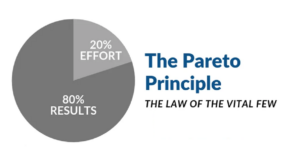If you’ve ever worked on a product development project, you know how overwhelming it can be. With deadlines looming and budgets tight, it’s easy to feel like everything is a priority. But the truth is, that not all features, tasks, or challenges carry the same weight. That’s where the Pareto Principle—aka the 80-20 rule—comes in.
What Is the Pareto Principle?
The Pareto Principle is a simple idea highlighting that 80% of the results come from just 20% of the efforts.
Italian economist Vilfredo Pareto first noticed this principle when he found that 80% of Italy’s wealth was owned by just 20% of the population. While it started as an economic observation, the Pareto Principle now applies to countless areas.
This Pareto pattern shows up in every dominant walk of our lives.
- In business: 80% of profits often come from 20% of customers.
- In sports: 20% of players usually score 80% of the points.
- In fundraising: 80% of donations typically come from 20% of donors
When it comes to product development, this principle emphasizes that roughly 80% of the value or impact of a product comes from only 20% of its features.
Pareto’s rule highlights how a handful of key features or tasks often drive the most impact, shaping user satisfaction, engagement, and overall business success. Instead of spreading resources thin, focusing on the most valuable 20% can make all the difference.
Why Pareto’s Principle Matters in Product Development
Think of product development like an iceberg—only 20% of it is visible above water, but that part creates most of the impact. Similarly, only a handful of features will really drive value for your customers. That’s what Pareteo’s principle is all about! It’s helping teams to create impact by focusing on the 20% of features or functionalities that will generate the most significant value for users, eventually leading to more efficient development and better product outcomes by avoiding unnecessary work on less impactful elements.
Businesses with Pareto’s principle in action work smarter instead of harder. When Instagram first launched, for instance, it focused on photo sharing and filters—that’s it. No videos, stories, or reels. Those two features made up the core 20% that drove 80% of the user engagement, helping Instagram grow fast.
Using the 80-20 Rule to Make Smart Decisions in Product Development
Two things are always in the product development process; time and money. Pareto’s principle helps teams to save both by finding the most vital elements, the 20 %. The hardest part is figuring out which 20% of your product matters most.
Here’s how you can use the Pareto Principle to guide your development process:
-
Prioritize Features That Make the Biggest Impact
Instead of building everything immediately, focus on the most valuable functions first. When Tesla launched its first cars, it didn’t worry about a built-in entertainment system or fancy interior options. They focused on long battery life and fast charging because those were the top priorities for EV customers.
-
Use Resources Wisely
Instead of spreading your budget and time thin across every possible improvement, focus on the key areas that deliver the most value.
A new fitness app, for instance, doesn’t need to launch with meal tracking, sleep monitoring, and community forums right away. Instead, it should perfect workout tracking—the core 20% that will drive 80% of user engagement.
-
Identify Problems That Could Derail the Project
If there’s a big risk that could slow everything down, tackle it early instead of ignoring it.
SpaceX didn’t start by designing the perfect spacecraft interior—they focused first on making rockets land safely because that was the biggest technical challenge.
While the numbers aren’t set in stone, the takeaway is clear—focusing on what truly matters makes a product stronger, more efficient, and more user-friendly. Instead of spreading resources too thin, smart teams double down on the features that users love and fix the pain points that cause the most friction.
How to Improve Product Development Efficiency with Pareto Principle
When developing a product, it’s easy to get caught up in features and possibilities. But in reality, only a few things truly matter—the “vital few.” Identifying these early can save time, reduce costs, and keep your team focused on what drives real success.
Here’s how to find the vital few at each stage of product development, with real-life examples:
1. Define the Core User Needs (Concept & Research Phase)
Before writing a single line of code or designing a prototype, ask:
- What is the absolute must-have function of this product?
- What problem are we solving?
Think of it like a Minimum Viable Product (MVP)—the basic version that delivers real value. Everything else is extra. A study by Miro determined that 3 out of 4 product teams that follow the 80/20 rule reported better outcomes for their users.
Real-Life Example: When the first Apple iPhone launched in 2007, its core focus was a touchscreen phone with internet browsing and music playback. Apple left out features like copy-paste and an app store until later versions. Instead of cramming in everything at once, they focused on what mattered most to users at the time.
2. Consider the Full Product Lifecycle (Design & Prototyping Phase)
A product isn’t just about how it works—it’s about how it’s made, shipped, serviced, and eventually disposed of. Ask yourself:
- Will it be easy to manufacture and scale?
- How will it be repaired or updated?
Real-Life Example: Tesla’s electric cars were designed with software updates in mind from day one. Instead of requiring customers to visit a service center for every small fix, Tesla enabled over-the-air software updates, making it easy to improve performance and fix bugs remotely—just like a smartphone.
A survey by Delve found that companies leveraging the Pareto Principle in their development process experienced up to a 30% reduction in time-to-market.
3. Factor in Key Stakeholders (Development & Testing Phase)
Beyond end users, many people interact with the product—engineers, manufacturers, service teams, and regulators. If you ignore them, you could face expensive changes later.
- Manufacturing: Can it be assembled efficiently with existing tools?
- Servicing: Does it require a special tool for repairs?
- Regulations: Does it meet industry safety and compliance standards?
Real-Life Example: When Dyson designed its cordless vacuum cleaners, they worked closely with manufacturers and repair teams. Early models had a sealed battery that required an entire unit replacement if damaged. However, after feedback from technicians, newer models allowed battery swaps, extending the product’s lifespan and reducing service costs.
4. Identify Risks Early (Pre-Launch & Production Phase)
Many projects get delayed or fail because risks weren’t tackled early enough. Instead of avoiding tough questions, ask:
- What’s the biggest risk to this product’s success?
- Can we actually achieve the right cost, durability, and size?
Real-Life Example: When SpaceX was developing reusable rockets, one of the biggest risks was whether a rocket could land safely after launch. Instead of waiting until full-scale production, they focused early efforts on testing and refining rocket landings—even if it meant multiple failures. By solving this core problem first, they made commercial space travel a reality.
Why Pareto’s Principle Matters in Product Development
By focusing on the vital few, teams can:
✔ Avoid wasted effort on unnecessary features
✔ Prevent costly last-minute redesigns
✔ Deliver a product that meets real user and market needs
✔ Reduce risk and increase the chance of a successful launch
At every stage of product development, keeping the vital few in mind helps build smarter, more efficient, and more impactful products—just like Apple, Tesla, Dyson, and SpaceX have done.
Dividing and conquering the most critical 20%, offers optimization of assets, improvement in product value, and a higher success rate of the product in the business environment.
Brand New MD understands the importance of these simple yet effective strategies and is proud to state that we facilitate high-quality results that exceed client expectations through backed research analysis. Reach out to us so we can show you how we can enhance your product development processes.










